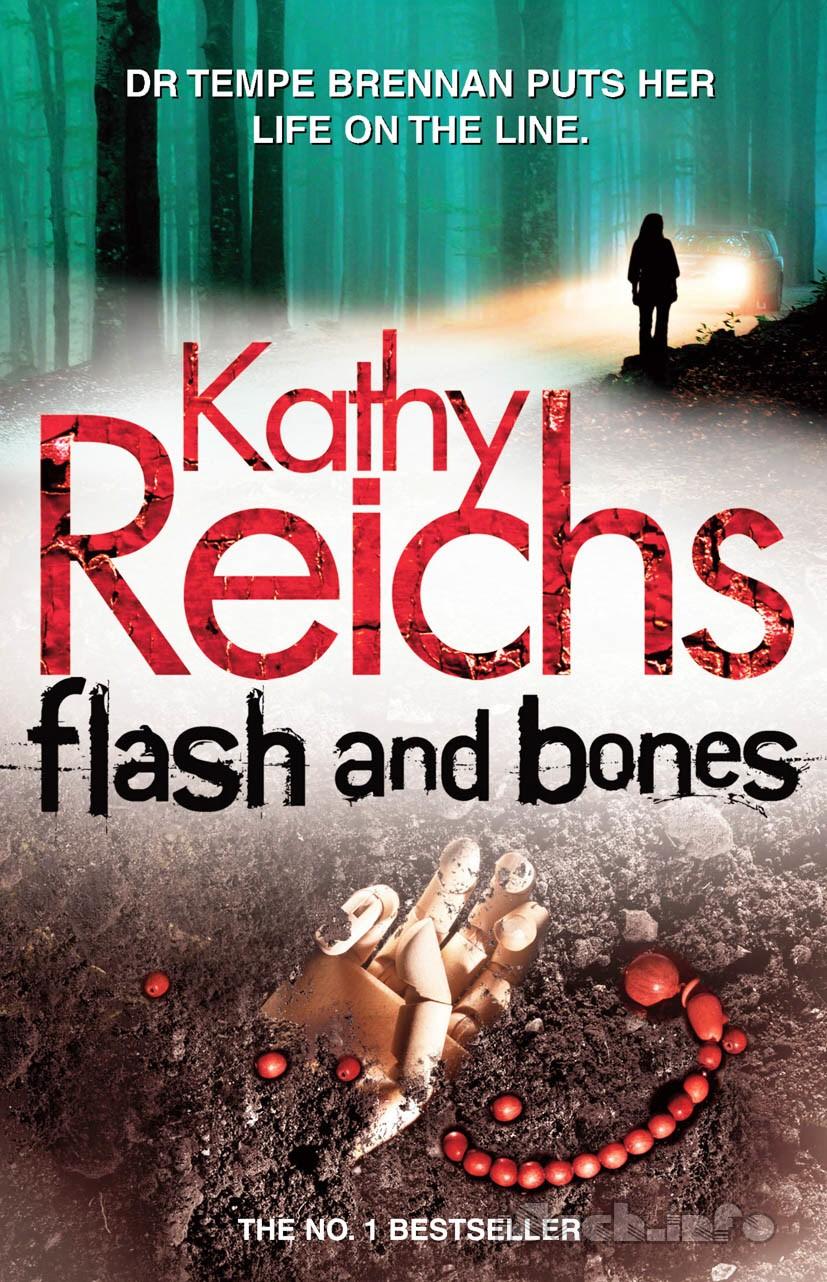Chapter 3
G
ENERATION? UPBRINGING? HORMONES? I’VE NO CLUE THE reason, but in the presence of attractive Y-chromosomers, Mrs. Flowers blushes and her voice goes breathy.“Dr. Brennan, I’d like to present Wayne Gamble.”
I looked up.
Standing in my doorway was a compact man with intense brown eyes and dark blond hair cut short and combed straight back. He wore jeans and a black knit polo with a Hilderman Motorsports logo stitched in red.
I laid down my pen.
Gamble stepped into the office and held out a hand. His grip was firm but not a testosterone crusher.
“Please have a seat.”
I gestured at a chair on the far wall. Meaning six feet from my desk. Gamble dragged it forward, sat, and planted his palms on his knees.
“Can I get you anything?” Marilyn crooning birthday wishes to the prez. “Water? A soft drink?”
Gamble shook his head. “No, ma’am.”
Mrs. Flowers remained fixed in the hall.
“Perhaps it’s best if you close the door,” I said gently.
Cheeks flaming, Mrs. Flowers did as requested.
“What can I do for you, Mr. Gamble?”
For a moment the man just stared at his hands. Reconsidering? Choosing his words?
I wondered at his reticence. After all, he’d come to me. Why such caution?
“I’m the jackman for Stupak’s fifty-nine car.”
My confusion must have been obvious.
“The Sprint Cup Series? Sandy Stupak?” he said.
“He’s a NASCAR driver.”
“Sorry. Yeah. Stupak drives the fifty-nine Chevy for Hilderman Motorsports. I’m on his pit crew.”
“Thus your photo in People.”
Gamble gave a self-deprecating grin. “They did a spread on racing and I got caught in some of the shots. The photographer was aiming at Sandy.”
“You’re in town for the Coca-Cola 600?” Flaunting my minuscule knowledge of NASCAR.
“Yeah. Actually, I live in Kannapolis, just down the road. Raised there.” Again Gamble hesitated, obviously uncomfortable. “My sister, Cindi, was two years older than me.”
The verb tense clued me where this was going.
“Cindi went missing her senior year of high school.”
I waited out another pause.
“I read in the paper you found a body in the dump out by the Speedway. I’m wondering if it could be her.”
“When did your sister disappear?”
“1998.”
Molene thought the drum holding our John/Jane Doe had eroded from an area of the landfill active at that time. I kept this fact to myself. “Tell me about her.”
Gamble pulled a snapshot from his pocket and flipped it onto my desk. “That was taken just a couple of weeks before she went missing.”
Cindi Gamble looked like she could have modeled for yogurt ads. Her teeth were perfect, her skin flawless and lousy with health. She had a blond pixie bob and wore a silver loop in each ear.
“Are those cars on her earrings?” Returning the photo.
“Cindi wanted to be a NASCAR driver in the worst way. Drove go-karts from the time she was twelve, moved up to legends.”
Again, I must have looked lost.
“Little single-seat cars for beginners. Legends driving trains kids so they can advance to real short-course racing.”
I nodded, not really understanding.
Gamble didn’t see. His eyes were on the photo still in his hand. “Funny how life turns out. In high school I was all about football and beer. Cindi hung with the science geeks. Loved cars and engines. NASCAR was her dream, not mine.”
Though anxious for Gamble to get on with his story, I didn’t interrupt.
“The summer before her senior year, Cindi started dating another wannabe driver, a guy named Cale Lovette. That fall, Cindi and Cale both vanished. Bang. Gone without a trace. No one’s seen them since.”
Gamble’s eyes met mine. In them I saw apprehension. And resurrected pain.
“My folks went crazy. Posted flyers all over town. Handed them out in malls. Nothing.” Gamble wiped his palms on his jeans. “I’ve got to know. Could that body be my sister?”
“What makes you think Cindi is dead?”
“The police said the two of them left town together. But Cindi’s whole life was NASCAR. I mean, she was on fire to drive. What better place to do that than Charlotte? Why would she just pick up and leave? And she’s never turned up anywhere else.”
“There was an investigation?”
Gamble snorted in disgust. “The cops poked around for a while, decided Cindi and Cale took off to get married. She was too young to do that without parental approval.”
“You doubt that theory?”
Gamble’s shoulders rose, fell. “Hell, I don’t know what to believe. Cindi didn’t confide in me. But I’m sure my folks would never have agreed to her marrying Cale.”
“Why?”
“She was seventeen. He was twenty-four. And rolled with a pretty rough crowd.”
“Rough?”
“White-supremacist types. Hated blacks, Jews, immigrants. Hated the government. Back then I suspected Cale’s racist buddies might be involved. But what would they have against Cindi? I don’t know what to think.”
Gamble shoved the photo back in his pocket.
“Mr. Gamble, it’s unlikely that the person we recovered is your sister. I’m about to begin my analysis. If you’ll leave contact information, I’ll inform you when I’ve finished.”
I passed across pen and paper. Gamble scribbled something and handed them back.
“Should it prove necessary, could you obtain Cindi’s dental records?”
“Yeah.”
“Would you or another maternal relative be willing to provide a DNA sample?”
“It’s just me now.”
“What about Lovette?”
“I think Cale’s father still lives around here. If I can find a listing, I’ll give him a call.”
Gamble got to his feet.
I rose and opened the door.
“I’m truly sorry for your loss,” I said.
“I just keep pedaling to stay out front.”
With that odd comment, he strode down the hall.
I stood a moment, trying to recall news stories about Cindi Gamble and Cale Lovette. The disappearance of a seventeen-year-old kid should have generated a headline or two. Angel Leonitus certainly had.
I could not remember seeing anything on Gamble.
Vowing to research the case, I headed back to the stinky room.
The landfill drum was as I’d left it. I was circling the gurney, considering options, when Tim Larabee pushed through the door wearing street clothes.
Mecklenburg County’s chief medical examiner is a runner. Not the healthy knock-out-three-miles-in-the-neighborhood variety but the train-for-a-marathon-in-the-Gobi-Desert zealot. And it shows. Larabee’s body is sinewy and his cheeks are gaunt.
“Oh boy.” Larabee’s deep-set eyes were pointed at the gurney.
“Or girl,” I said. “Take a look.” I indicated the open end of the drum.
Larabee crossed to it and peered at the hand. “Any idea how much more is in there?”
I shook my head. “Can’t x-ray because of the metal and the density of the fill.”
“What’s your take?”
“Someone stowed a body or body parts, then filled the drum with asphalt. The hand was up top and became visible when the lid came off and the asphalt eroded.”
“Tight fit for an adult, but I’ve seen it done. Any dates on the sector where they found this thing?”
“A landfill worker said that area of the dump closed in 2005.”
“So it’s not Leonitus.”
“No. She’s too recent.”
“As of Monday, we got us another MP. Man came from Atlanta to Charlotte for Race Week. Wife reported him missing.” Larabee was studying the drum. “How will you get it out?”
How will I get it out?
Great.
Though I’d never freed remains from asphalt, I had liberated corpses from cement. In each case, because fats from the surface tissues had created a nonbinding surface, a small void had surrounded the body. I anticipated a similar situation here.
“The drum is no problem. We’ll cut through that. The asphalt is trickier. One option is to saw at horizontal and lateral planes to the block, then use an air hammer to create propagation cracks.”
“Or?”
“The other option is to chisel away as much asphalt as possible, then dip the block in solvent to dissolve what remains.”
“What kind of solvent?”
“Acetone or turpentine.”
Larabee thought a moment, then, “Asphalt and cement work damn well as sealants, so there might be fresh tissue preserved in there. Go with Plan A. Joe can help.”
“Joe’s out on a call.”
“He just got back.” Larabee changed the subject. “Have you examined the new sandpit bones?”
“Everything is consistent with the rest of the skeleton.”
“Music to my ears.” Larabee chin-cocked the drum. “Let me know how it goes.”
I was taking photos when Hawkins entered the autopsy room and strode to the gurney.
Cadaver-thin, with dark circles under puffy lower lids, bushy brows, and dyed black hair combed straight back from his face, Joe Hawkins looks like an older and hairier version of Larabee.
“How we going to crack this sucker?” Hawkins rapped gnarled knuckles on the drum.
I explained Plan A.
Without a word, Hawkins went in search of the necessary tools. I was finishing with overview shots when he returned, dressed in blue surgical scrubs identical to mine.
Hawkins and I donned goggles, then he inserted a blade, plugged in, and revved the handheld power saw.
The room filled with the whine of metal on metal and the acrid smell of hot steel. Rust particles arced and dropped to the gurney.
Five minutes of cutting, then Hawkins laid down the saw and tugged and twisted with his hands. The segment came free.
More cutting. More tugging.
Eventually a black lump lay on the gurney, and an exoskeleton of torn metal lay on the floor.
Joe killed the saw. Raising my goggles to my forehead, I stepped forward.
The asphalt cast was the exact shape and size of the drum’s interior. Objects grazed its surface, pale and ghostly as morgue flesh.
The curve of a jaw? The edge of a foot? I couldn’t be sure.
Hawkins switched to the air hammer and, with some direction from me, began working downward toward the body parts. As cracks formed, I freed chunks of asphalt and placed them on the counter. Later I would examine each and take samples so chemists could determine their elemental composition.
Maybe useful, maybe not. Better to be safe. One never knew what would later prove significant.
Slowly, the counter filled.
One hunk. Three. Nine. Fifteen.
As the cast shrank, its contour changed. A form took shape, like a figure emerging from a block of marble being sculpted.
The top of a head. An elbow. The curve of a hip.
At my signal, Joe set down the chisel. Using hand tools, I went at the remaining asphalt.
Forty minutes later a naked body lay curled on the stainless steel. The legs were flexed with the thighs tight to the chest. The head was down, the forehead pressed to the upraised knees. The feet pointed in opposite directions, toes spread at impossible angles. One arm L’ed backward. The other stretched high, fingers spread as though clawing for escape.
A sweet, fetid odor now rode the air. No surprise.
Though shriveled and discolored, overall, the cadaver was reasonably well preserved.
But that was changing fast.



 ePub
ePub A4
A4